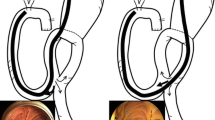Abstract
Background
Short-type double-balloon endoscope (DBE)-assisted endoscopic retrograde cholangiopancreatography (ERCP) has been developed as an alternative approach for cases with a surgically altered gastrointestinal anatomy. However, this technique is sometimes technically challenging and carries a risk of severe adverse events.
Aims
To evaluate the factors affecting the technical success rate and adverse events of DBE-ERCP.
Methods
A total of 319 patients (805 procedures) with a surgically altered gastrointestinal anatomy underwent short DBE-ERCP. The factors affecting the technical success rate and adverse events, and the learning curve of the trainees were retrospectively evaluated.
Results
The technical success rate of all procedures was 90.7%. Adverse events occurred in 44 (5.5%) procedures. A multivariate analysis indicated that Roux-en-Y reconstruction and first-time short DBE-ERCP were factors affecting the technical failure and adverse event rates, while the modified Child method after subtotal stomach-preserving pancreaticoduodenectomy reconstruction was a non-risk factor for adverse events. The trainee caseload did not affect the technical success or adverse event rates significantly; however, trainees tended to perform cases involving the modified Child method after subtotal stomach-preserving pancreaticoduodenectomy reconstruction. The success rate of scope insertion increased according to experience; however, the overall success rate did not differ to a statistically significant extent.
Conclusion
Short DBE-ERCP was useful and safe for managing cases with a surgically altered anatomy; however, trainees should concentrate on accumulating experience with easy cases, such as those with the modified Child method after subtotal stomach-preserving pancreaticoduodenectomy reconstruction or a history of DBE-ERCP.



Similar content being viewed by others
References
Wright BE, Cass OW, Freeman ML. ERCP in patients with long-limb Roux-en-Y gastrojejunostomy and intact papilla. Gastrointest Endosc. 2002;56:225–232.
Yamamoto H, Sekine Y, Sato Y, et al. Total enteroscopy with a nonsurgical steerable double-balloon method. Gastrointest Endosc. 2001;53:216–220.
Monkemuller K, Bellutti M, Neumann H, et al. Therapeutic ERCP with the double-balloon enteroscope in patients with Roux-en-Y anastomosis. Gastrointest Endosc. 2008;67:992–996.
Shimatani M, Matsushita M, Takaoka M, et al. “Short” double balloon enteroscope for endoscopic retrograde cholangiopancreatography with conventional sphincterotomy and metallic stent placement after Billroth II gastrectomy. Endoscopy. 2009;41:E19–E20.
Shimatani M, Hatanaka H, Kogure H, et al. Diagnostic and therapeutic endoscopic retrograde cholangiography using a short-type double-balloon endoscope in patients with altered gastrointestinal anatomy: a multicenter prospective study in Japan. Am J Gastroenterol. 2016;111:1750–1758.
May A, Nachbar L, Ell C. Double-balloon enteroscopy (push-and-pull enteroscopy) of the small bowel: feasibility and diagnostic and therapeutic yield in patients with suspected small bowel disease. Gastrointest Endosc. 2005;62:62–70.
Shimatani M, Matsushita M, Takaoka M, et al. Effective “short” double-balloon enteroscope for diagnostic and therapeutic ERCP in patients with altered gastrointestinal anatomy: a large case series. Endoscopy. 2009;41:849–854.
Khashab MA, El Zein MH, Sharzehi K, et al. EUS-guided biliary drainage or enteroscopy-assisted ERCP in patients with surgical anatomy and biliary obstruction: an international comparative study. Endosc Int Open. 2016;4:E1322–E1327.
Elton E, Hanson BL, Qaseem T, et al. Diagnostic and therapeutic ERCP using an enteroscope and a pediatric colonoscope in long-limb surgical bypass patients. Gastrointest Endosc. 1998;47:62–67.
Hintze RE, Adler A, Veltzke W, et al. Endoscopic access to the papilla of Vater for endoscopic retrograde cholangiopancreatography in patients with billroth II or Roux-en-Y gastrojejunostomy. Endoscopy. 1997;29:69–73.
Aabakken L, Bretthauer M, Line PD. Double-balloon enteroscopy for endoscopic retrograde cholangiography in patients with a Roux-en-Y anastomosis. Endoscopy. 2007;39:1068–1071.
Itoi T, Ishii K, Sofuni A, et al. Long- and short-type double-balloon enteroscopy-assisted therapeutic ERCP for intact papilla in patients with a Roux-en-Y anastomosis. Surg Endosc. 2011;25:713–721.
Voiosu T, Bengus A, Voiosu A, et al. Trainee caseload correlates with ERCP success rates but not with procedure-related complications: results from a prospective study (the QUASIE cohort). Endosc Int Open. 2016;4:E409–E414.
Frost JW, Kurup A, Shetty S, et al. Does the presence of a trainee compromise success of biliary cannulation at ERCP? Endosc Int Open. 2017;5:E559–E562.
Kashani A, Abboud G, Lo SK, et al. Double balloon enteroscopy-assisted endoscopic retrograde cholangiopancreatography in Roux-en-Y gastric bypass anatomy: expert vs. novice experience. Endosc Int Open. 2018;6:E885–E891.
Yane K, Katanuma A, Maguchi H, et al. Short-type single-balloon enteroscope-assisted ERCP in postsurgical altered anatomy: potential factors affecting procedural failure. Endoscopy. 2017;49:69–74.
Tomoda T, Tsutsumi K, Okada H. Comparison between Roux-en-Y patients with and without gastrectomy during endoscopic retrograde cholangiopancreatography using a short double-balloon enteroscope. Dig Endosc. 2015;27:775.
Tsutsumi K, Kato H, Hirao K, et al. Comparison of two fluoroscopic images to ensure efficient scope insertion for biliary intervention in patients with Roux-en-Y hepaticojejunostomy. Endoscopy. 2017;49:1256–1261.
Tsutsumi K, Kato H, Muro S, et al. ERCP using a short double-balloon enteroscope in patients with prior pancreatoduodenectomy: higher maneuverability supplied by the efferent-limb route. Surg Endosc. 2015;29:1944–1951.
Author information
Authors and Affiliations
Corresponding author
Ethics declarations
Conflict of interest
The authors declare no conflict of interests for this article.
Additional information
Publisher's Note
Springer Nature remains neutral with regard to jurisdictional claims in published maps and institutional affiliations.
Rights and permissions
About this article
Cite this article
Uchida, D., Tsutsumi, K., Kato, H. et al. Potential Factors Affecting Results of Short-Type Double-Balloon Endoscope-Assisted Endoscopic Retrograde Cholangiopancreatography. Dig Dis Sci 65, 1460–1470 (2020). https://doi.org/10.1007/s10620-019-05857-3
Received:
Accepted:
Published:
Issue Date:
DOI: https://doi.org/10.1007/s10620-019-05857-3




